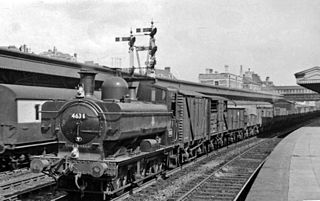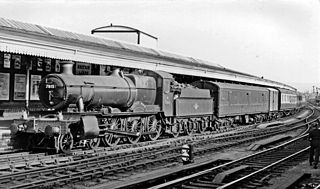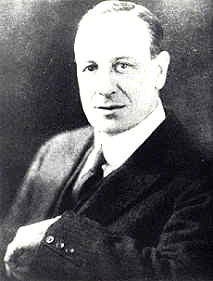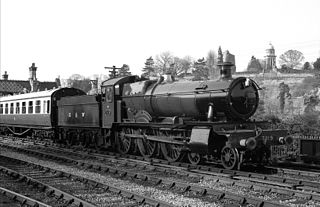| King George V | |||||||||||||||||||||||||||||||||||||||||||||||||||||||||
|---|---|---|---|---|---|---|---|---|---|---|---|---|---|---|---|---|---|---|---|---|---|---|---|---|---|---|---|---|---|---|---|---|---|---|---|---|---|---|---|---|---|---|---|---|---|---|---|---|---|---|---|---|---|---|---|---|---|
 GWR No. 6000 King George V at STEAM – Museum of the Great Western Railway, Swindon | |||||||||||||||||||||||||||||||||||||||||||||||||||||||||
| |||||||||||||||||||||||||||||||||||||||||||||||||||||||||
| |||||||||||||||||||||||||||||||||||||||||||||||||||||||||
| |||||||||||||||||||||||||||||||||||||||||||||||||||||||||
| |||||||||||||||||||||||||||||||||||||||||||||||||||||||||
Great Western Railway (GWR) 6000 Class King George V is a preserved British steam locomotive.
| King George V | |||||||||||||||||||||||||||||||||||||||||||||||||||||||||
|---|---|---|---|---|---|---|---|---|---|---|---|---|---|---|---|---|---|---|---|---|---|---|---|---|---|---|---|---|---|---|---|---|---|---|---|---|---|---|---|---|---|---|---|---|---|---|---|---|---|---|---|---|---|---|---|---|---|
 GWR No. 6000 King George V at STEAM – Museum of the Great Western Railway, Swindon | |||||||||||||||||||||||||||||||||||||||||||||||||||||||||
| |||||||||||||||||||||||||||||||||||||||||||||||||||||||||
| |||||||||||||||||||||||||||||||||||||||||||||||||||||||||
| |||||||||||||||||||||||||||||||||||||||||||||||||||||||||
| |||||||||||||||||||||||||||||||||||||||||||||||||||||||||
Great Western Railway (GWR) 6000 Class King George V is a preserved British steam locomotive.
After developing the "new" GWR Star Class in the form of the GWR Castle Class, chief mechanical engineer Charles Collett was faced with the need to develop an even more powerful locomotive to pull 13+ carriage express trains. [1]
Collett successfully argued with the GWR's General Manager, Sir Felix Pole, that had the axle-loading restriction of 19.5 long tons (19,800 kg) of the "Castle" class been increased to the maximum allowable of 22.5 long tons (22,900 kg), an even more powerful locomotive could have been created. Pole agreed to allow Collett to explore such a design, subject to getting tractive effort above 40,000 lbf (180,000 N). [1]
Collett designed the "King" Class to the maximum dimensions of the original GWR 7 ft 1⁄4 in (2,140 mm) broad-gauge engineering used to develop its mainline, [1] resulting in the largest loading gauge of all the pre-nationalisation railways in the UK, with a maximum height allowance of 13 feet 5 inches (4.09 m). [1] Consequently, this restricted them as to where they could operate under both GWR and British Railways ownership. [1] To accommodate the largest possible boiler, and to conform with Pole's requested tractive effort requirement, the "King" class were equipped with smaller 6 ft 6 in (1.981 m) main driving wheels than the "Castle" class. This resulted in both the GWR's highest-powered locomotive design, but most importantly a higher tractive effort than the "Castle". This combination allowed the "King" class to pull the now required higher-weight 13+ coach express trains from London to Bristol and onwards to the West Country, at a higher-speed timetable average than the "Castle". [1]
With the class to be originally named after notable cathedrals, in light of the invitation to feature in the Baltimore and Ohio Railroad's centenary celebrations, the GWR decided to make them more notable by naming the class after British Kings. [1]

As the first of the class, No. 6000 was specifically named after the then monarch of the United Kingdom King George V. Built at Swindon Works and completed in June 1927, following a period of running in, the locomotive was shipped to the United States in August 1927, to feature in the B&O's centenary celebrations. During the celebrations it was presented with a bell and a plaque, and these are carried to this day. This led to it being affectionately known as "The Bell". The bell carries the inscription:
| Presented to Locomotive King George V |
After returning from the US it was allocated to Old Oak Common. Moved by British Railways to Bristol in 1950, it was returned to Old Oak Common in 1959, and withdrawn by the Western Region of British Railways in December 1962 after covering 1,910,424 miles (3,074,529 km).
The locomotive was officially preserved as part of the national collection. It was restored to main line running order at the Bulmer's Railway Centre in Hereford. Operationally based at Hereford, in 1971 it became the very first steam locomotive to break the British Railways mainline steam ban that had been in place since the completion of the Fifteen Guinea Special in 1968. Its restoration to main line service and subsequent operation is often credited with opening the door for the return of steam to the mainlines of the UK.
The engine took part in the GWR150 celebrations in 1985 hauling railtours, one trip which took place on 7 Apr was "The Great Western Limited" which was running from London Paddington to Plymouth via Bristol was booked to be worked by No. 6000 while double heading with No. 7819 Hinton Manor. Both engines we're to double head the train from Bristol to Plymouth on the outward journey but No. 6000 was failed in Taunton with a hot box and had to be taken off the train. No. 7819 Hinton Manor continued alone with the train but that would too later be failed in Exeter with a hot box. [2]
After years of running, a costly overhaul of the locomotive was declined by the National Railway Museum. In part, this was due to the fact that, since its second renovation, a second class-member King Edward I had been restored for mainline operation. In addition, the higher ballast beds in place on the Western Region since the early 1980s, to allow for the high speed running of the InterCity 125 train sets, have greatly reduced the running-level loading gauge of the former GWR mainline – especially under bridges – to 13 feet 1 inch (3.99 m), so enabling mainline running of a "King" class now requires a reduction in the height of the original GWR-built chimney, cab and safety valve bonnets by 4 inches (100 mm), as had been done on the restoration of King Edward I. No. 6000 is the only one of the three preserved "King" class locomotives to retain its original-built full-height fittings.
After closure of the Bulmer's Steam Centre in 1990, No. 6000 moved to the Swindon "Steam" Railway Museum. In 2008, it swapped places with No. 92220 Evening Star, and became resident at the National Railway Museum. In late 2015, No. 6000, along with City of Truro, returned to STEAM – Museum of the Great Western Railway (located at the site of the old railway works in Swindon), and both were put on display in preparation for Swindon 175 (in 2016), celebrating 175 years since the inception of Swindon as a railway town. [3] [4] Both locomotives are expected to remain at Swindon for 5 years. [3]

The Great Western Railway (GWR) was a British railway company that linked London with the southwest, west and West Midlands of England and most of Wales. It was founded in 1833, received its enabling act of Parliament on 31 August 1835 and ran its first trains in 1838 with the initial route completed between London and Bristol in 1841. It was engineered by Isambard Kingdom Brunel, who chose a broad gauge of 7 ft —later slightly widened to 7 ft 1⁄4 in —but, from 1854, a series of amalgamations saw it also operate 4 ft 8+1⁄2 in standard-gauge trains; the last broad-gauge services were operated in 1892.

The Great Western Railway 4000 or Star were a class of 4-cylinder 4-6-0 passenger steam locomotives designed by George Jackson Churchward for the Great Western Railway (GWR) in 1906 and introduced from early 1907. The prototype was built as a 4-4-2 Atlantic. They proved to be a successful design which handled the heaviest long-distance express trains, reaching top speeds of 90 mph (145 km/h), and established the design principles for GWR 4-cylinder classes over the next twenty-five years.

The 4073 or Castle Class are 4-6-0 steam locomotives of the Great Western Railway, built between 1923 and 1950. They were designed by the railway's Chief Mechanical Engineer, Charles Collett, for working the company's express passenger trains. They could reach speeds of up to 100 mph (160 km/h).

George Jackson Churchward was an English railway engineer, and was chief mechanical engineer of the Great Western Railway (GWR) in the United Kingdom from 1902 to 1922.

STEAM – Museum of the Great Western Railway, also known as Swindon Steam Railway Museum, is housed in part of the former railway works in Swindon, England – Wiltshire's 'railway town'. The 6,500-square-metre (70,000 sq ft) museum opened in 2000.

5051 Drysllwyn Castle is a Great Western Railway (GWR) Castle Class locomotive built at Swindon Works in May 1936 and named after Dryslwyn Castle. It is owned by the Didcot Railway Centre.

GWR 4073 "Castle" Class No. 4079 Pendennis Castle is a 4-6-0 steam locomotive built in 1924 for the Great Western Railway (GWR) at Swindon Works to a design of Charles Collett. It was employed on long-distance express passenger trains on the GWR and its successor, British Railways' Western Region.

The Great Western Railway 4900 Class or Hall Class is a class of 4-6-0 mixed-traffic steam locomotives designed by Charles Collett for the Great Western Railway. A total of 259 were built at Swindon Works, numbered 4900–4999, 5900–5999 and 6900–6958. The LMS Stanier Class 5 4-6-0 and LNER Thompson Class B1 both drew heavily on design features of the Hall Class. After nationalisation in 1948, British Railways gave them the power classification 5MT.

The GWR 5700 Class is a class of 0-6-0 pannier tank steam locomotive built by the Great Western Railway (GWR) and British Railways (BR) between 1929 and 1950. With 863 built, they were the most prolific class of the GWR, and one of the most numerous classes of British steam locomotive.

The Great Western Railway (GWR) 7800 Class or Manor Class is a class of 4-6-0 steam locomotive. They were designed as a lighter version of the Grange Class, giving them a wider Route Availability. Like the 'Granges', the 'Manors' used parts from the GWR 4300 Class Moguls but just on the first batch of twenty. Twenty were built between 1938 and 1939, with British Railways adding a further 10 in 1950. They were named after Manors in the area covered by the Great Western Railway. Nine are preserved.

The Great Western Railway (GWR) 2251 Class or Collett Goods Class was a class of 0-6-0 steam tender locomotives designed for medium-powered freight. They were introduced in 1930 as a replacement for the earlier Dean Goods 0-6-0s and were built up to 1948.

The Great Western Railway (GWR) 6000 Class or King Class is a class of 4-6-0 steam locomotives designed for express passenger work and introduced in 1927. They were the largest locomotives built by the GWR, apart from the unique Pacific. The class was named after kings of the United Kingdom and of England, beginning with the then reigning monarch, King George V, and going back through history. They handled the principal GWR expresses on the main line from London to the West of England and on the Chiltern line to Birmingham and Wolverhampton, until 1962 when the class was withdrawn.

Swindon Works was opened by the Great Western Railway in 1843 in Swindon, Wiltshire, England. It served as the principal west England maintenance centre until closed in 1986.

6024 King Edward I is a preserved Great Western Railway (GWR) 6000 Class steam locomotive operated from 1930 to 1962 by the Great Western Railway and latterly British Railways hauling express passenger services.

Great Western Railway (GWR) 6000 Class 6023 King Edward II is a preserved steam locomotive.

Charles Benjamin Collett was Chief Mechanical Engineer of the Great Western Railway from 1922 to 1941. He designed the GWR's 4-6-0 Castle and King Class express passenger locomotives.

The Great Western Railway (GWR) 4700 Class was a class of nine 2-8-0 steam locomotives, designed by George Jackson Churchward. They were introduced in 1919 for heavy mixed-traffic work. Although primarily designed for fast freight, the class also sometimes hauled passenger trains, notably heavy holiday expresses in the summer months. They were unofficially nicknamed "Night Owls" because they were primarily designed to haul goods during the night and they could be seen simmering in the daylight, awaiting their nocturnal duties.

GWR 4073 Class No. 7029 Clun Castle is a 4-6-0 steam locomotive built at Swindon Works in May 1950 to a design by Charles Collett for operation on the Western Region of British Railways. It was named after Clun Castle in Shropshire.

4930 Hagley Hall is a Great Western Railway, 4-6-0 Hall class locomotive, built in May 1929 at Swindon Works to a design by Charles Collett. It is one of eleven of this class that made it into preservation. The locomotive is named after Hagley Hall in Worcestershire.

7819 Hinton Manor is a Great Western Railway locomotive part of the Manor Class. It is one of 9 locomotives preserved from the class which originally had 30.